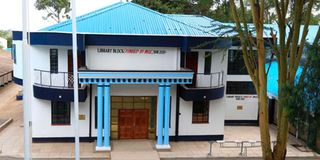
Nanyuki School in Laikipia County.
| Joseph Kanyi | Nation Media GroupLaikipia
Premium
What’s Kenya’s most desirable school? Not what you think
The most desirable school in Kenya drew more than 154,000 KCPE applicants, and it is not one of those household names that dominate the newspapers every year with top scorers.
The main attraction of Nanyuki School, on the outskirts of Nanyuki town in Laikipia County, is its focus on technical training and a steady improvement in academic performance over the past four years.
The applicants were battling for 384 available slots at the school, said Education Cabinet Secretary George Magoha when Form One selections for the 2020 class began.
The school’s total population is less than 1,000 students.
From its majestic administration block to its library and well-maintained classrooms, Nanyuki School exudes an aura of academic confidence to anyone who walks in.

Students at Nanyuki School learn how to fly a plane on a simulator on June 22, 2021.
Focus
The boys’ demeanour - hurried gait, quiet calm - shows a level of focus that justifies the school’s national status.
The school has a strict schedule that it has been following for years and it is incorporated not just into the lives of students but those of the teachers as well.
That schedule is credited for the significant growth in the school’s KCSE performance in the last four years, says Gitonga King’ori, the deputy principal in charge of academics.
The school opened in 1964 for white settler children in Laikipia. It was officially registered in 1969 as a three-streamed day and boarding school.
It has continued to grow since the initial 35 students were admitted and now has 782. The school sits on 53 acres at the base of Mt Kenya, just outside Nanyuki town.
Its geographical location makes it relatively warmer than most of areas around the mountain.
The school day starts at 5am, when the boys are supposed to be in class for preps, and ends at 9.30 in the evening.

Nanyuki School Principal Oliver Minishi. He says students do most of the talking at assembly and some even do presentations
Students take charge
During assembly, students are in charge of the activities and teachers take very little time addressing them. They are allowed to make project presentations in their subjects or clubs.
This, Principal Oliver Minishi says, helps in boosting their confidence and encouraging them to read more and widely.
“We have made the students own the school assembly, in that they do most of the talking and some even do presentations. On Monday this week, during the assembly, geography students made a presentation about the erupting volcano. We want to inject learning into all our activities,” he says.
Between 8am and 4pm, students are engaged with their teachers all through. Teachers strive to complete their syllabuses by the first term of the final year and this gives students enough time to revise before the KCSE examination.

Nanyuki School Deputy Principal Gitonga King'ori. He is in charge of academics.
Multiple exams
They take multiple exams to keep them in a reading mode all through. They are given the working syllabus, which they use to revise for the tests. They do a minimum of four exams every term.
“We do target studying and testing. This means that we tell them that we will test on Form Two work and that is what they read and we strictly test on that,” Mr King’ori says.
These changes, he says, have seen the school’s mean score rise from 5.84 in 2017 to 6.71 in 2018, 7.82 in 2019 and 8.68 in the 2020 KCSE results released last month.
The school has also introduced technical subjects.
From aviation, electricity and building to wood work, agriculture, computer and French, Nanyuki School has given its students a variety of technical subjects to choose from as it embraces the new competency based curriculum.

The library at Nanyuki School.
Technical subjects
All Form One students pick one technical subject that they pursue to the final year or drop it during the Form Two subjects’ selection.
The subjects are aimed at giving the boys the skills they will need out in the world when they complete Form Four and nurture their talents.
“We want to introduce more subjects like home science, film and others so that they have more choices. We have skilled teachers to teach them,” Mr Minishi says.
“The technical skills perform very well, and in the 2020 KCSE the first lot of aviation students managed a mean score of 10 points. The 29 students in wood work had a mean of 11.5 points, which was a drop from 12 points in the previous year, and the 18 computer students managed an 11.8 mean,” Mr King’ori adds.
Other academic policies include multiple benchmarking, capacity building, parent-teacher policies, integration of ICT in learning and the involvement of students in teaching and learning.
The administration has also devolved its duties, creating form administrations, complete with a principal, deputy and career manager.
This, Mr Minishi says, has cascaded down the management to students where many issues are handled at that level, making it easier for students to speak up and interact with their teachers.





